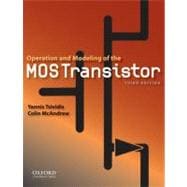Operation and Modeling of the MOS Transistor has become a standard in academia and industry. The book provides a thorough treatment of the MOS transistor-the key element of most modern microelectronic chips. The Third Edition of this well respected book is fully updated, making several key improvements in content, organization and pedagogy. The text has also been enhanced by changing notation to standard units of measurement, introducing an "Overview of the MOS Transistor" in the first chapter, and increasing the number of examples.
New to this edition:
* Energy bands and the energy barrier viewpoint are integrated into the discussion in a smooth, simple manner
* Expanded discussion of small-dimension effects, including velocity saturation, drain-induced barrier lowering, ballistic operation, polysilicon depletion, quantum effects, gate tunneling current, and gate-induced drain leakage
* Expanded discussion of small-signal modeling, including gate and substrate current modeling and flicker noise
* New chapter on substrate nonuniformity and structural effects, discussing transversal and lateral (halo) doping nonuniformity, stress and well proximity effects, and statistical variability
* A completely re-written chapter on modeling for circuit simulation, covering the considerations and pitfalls in the development of models for computer-aided design
* Extensively updated bibliography
* An accompanying website includes additional details not covered in the text, as well as model computer code








